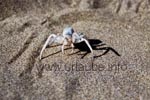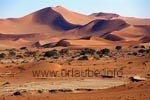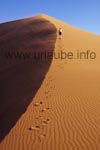Desert tours in Namibia

Namibia is a dry country in which the deserts dominate in the landscape. There is the Namib in the west, the "place where there is nothing", translated from the Nama-term. In the east there is the Kalahari, this semi-desert of sand and veld and all other parts of the country barely get some rain. Here, it is difficult to imagine there is another thing but not desert. But those who take up with these landscapes will recognize that they are of a distinctive attraction and that here is also life in multifaceted forms.
Namib desert - The desert lives
Swakopmund, the most "German" city of Namibia is really worthwhile seeing and also experiencing, but also the starting point for several different tours. The guide Guide Chris Nel offers very recommedable ones, for example "Living Desert", an unusual and highly interesting tour to explore the flora and the fauna of the Namib desert.

At first sight, the oldest desert of the world seems to be completely empty and out of live. But this impression deceives, as an experienced and knowledgeable guide will show a diversity of plants and animals that one would never have experienced here. As it practically never rains here, the nature applies a genial trick: all creatures make use of the dew that is carried from the atlantic by the coastal fog so that their existence is secured.

Where we, as big city people, only saw an endless surface, Chris, our guide, repeatedely found some traces. He could read from them whether they were old or new ones and from which animal they were. These experiences were taken over from the bushmen who are able to interprete the most tiny indication in the sand and for whom these traces have the same effect as an opened book. As soon as Chris found a trace was new and promised some "hunting success", he started to dig.

The first finding was the "white-lady", a white spider that, as almost all inhabitants ofd the desert, spends the day hidden in the sand. In order to escape from its enemy, the "Pombalid-wasp", it rolls by truning 44 times per second down the dunes and then "dances" at the bottom of the dune to defend itself.

We come across with a relative frequency to the "tok-tokkis", some black ground beetles that leave some imposing traces in the sand. They are the preferable food for some desert animals, those as for the desert chameleon. The "Sand-Diving Lizard" got its name from its unusual way to move forward. It rushes with a strange appearing dancing movement over the dunes in order not to burn its feet in the hot sand. In order to demonstrate that this animal is totally able to defend itself, Chris, undaunted by death, offered his finger to it in which the lizard promptly bit. But neither the lizard nor our guide got injured.
The palmato-gecko is of a very interesting and unusual appearance. It is an animal that appears to be transparent, so that the spinal column and the arteries are visible. This is also the reason why it is very susceptible to sunrays, can only be for a short time under the burning sun and spends the day buried in the sand; What is also worth to mention are its big eyes and the "duck feet"e".

In there are several "dollar bushes" standing in one spot, one should have a closer look. This bush which leaves save water and due to this, it is used by the Sans for surviving, is a popular place of the desert chameleon. We were lucky and found one of them. It is a fantastic feeling to look at this prehistorically appearing animal and also to hold it in the hand. Yes, we were allowed to hold it in out hands. This memory will remain, as this is an opportunity one seldom has. Our encounter with the chameleon was a misfortune for some tok-tokki-beetles. In order to be able to watch the chameleon catching its prey with its lightning tongue as long as its body, they were used as food.
Sidewinder snakes, locusts and scorpions also belong to the inhabitants of the Namib. We certainly did not achieve to find them, but the tour was anyway an impressive experience that we can further recommend unconditionally.
Moonscape and welwitschia
Those who visit Swakopmund will not miss to do a side trip to the moonscape and to the Welwitschia-plants. The name moonscape is justified, as it reminds on an image of earth's satellites with its scarce and rocky-sandy grey-brown underground. By the way, here, some American astronauts trained for their moon landings and also, this surreal appearing area also served as complexion for some advertising spots. But also this dead appearing landscape is full of live. The stones and the ground are covered with lichens that conserve their needed humidity through the fog that comes at night from the Atlantic. It is also the native place of the famous Welwitschia mirabilis, a plant that only exists in a very narowly limited place of Namibia and that can live thousand years.

We had actually planned to do the Welwitschia-tour through the moonscape by our own with the rented car. But we were so enthusiastic from the "Living-Desert-Tour" with Chris, our guide, that we also made use of his offer to join to this tour. Afterwards, we realized that this was a good decision. The tour can be made without any problem on one's own, but one has always keep the determined route; As a result, one has some few views to the moonscape from some view points and at the end there is one single but impressive Welwitschia.

But Chris, the guide, he has the concession for the trips to the moonscape. The impressions we got from this wild-romantic landscape were really breathtaking. Surely, this scarce and grey-brown area is not everyone's cup of tea, but those who did not lose the view for some interesting and impressive landscapes of all colours, will guaranteedly get their money worth. By the way,countless stories were told us, also we got some advices and facts about the geology, thwe flora and fauna of this area and could also proove some things immediately in some experiments. Only a few drops from the water bottle made the lichens and plants blossom within a few minutes, thus practically "to revive". This gave us a small idea of how this desertscape would turn after a rain in shortest time to a blossoming oasis. Unfortunately, this wonder only happens once a decade.

Then the moment came when we saw the first welwitschia, we could admire a total of 18 pieces in a small area. Surely, they were relatively "young" ones, thus barely some hundred years old. The youngest, the "baby", had only lived for 50 years. But it was imposing to stand in front of such historical plants, from which many already existed when there was medieval time in Europe. We could watch this welwitschia from the very proximity and without any disturbiung fence.
With some stones, Chris only built a small ring around the plant in order to mark where one can step in. The welwitschia has a fine root network, similar to a spider's web, that is arranged around its centre. If one steps on it, it will be destroyed. In the worst case, the plant dies. Unfortunately, those tourists coming on their own to this place are not aware of that and often destroy this net without knowing it.
At the end of the tour we drove through the river bed of the Swakop, that, as it is the case of all rivers of Namibia, is always dry except a few days a year. But its course is really noticeable as there is a dense vegetation there. After the moonscape, this river bed with its palms, camel-thorn-trees and bushes is even more remarkable and demonstrates the power reserves of the nature.
Sossusvlei in the Namib desert
The loam swale Sossusvlei is, as also the Etosha-park, the "figurehead" of Namibia and undoubtedely of a fascinating and affecting beauty. Located in the Namib desert, one of the most dry places on earth, the giant sand dunes heighted up to 385 m seem to rise to the sky. Some impressive plays of lights and shadows make the heart of the visitors beat faster, specially in the early morning and in the late afternoon, and also make clear why it is justified that the sand mountains around the swale of Sossusvlei are considered as the touristical highlight of Namibia.

Due to this reason, this area is respectively touristically arranged. There are numerous lodges and guest farms offering accommodation and service. But as also the demand is very high, it is recomendable to book in time.

The Sossusvlei-lodge, is a luxury accommodation that is right at the entrance of the touristical area of the Namib-Naukluft-park. It is one of the most expensive accommodations of Namibia, but therefore, the guest gets a time offered that does not leave anything to be desired. Big tents with all kinds of comfort, a catering that would dwarf many german star cuisines, a first-class service and numerous adventure offers provide some unforgettable holidays. But the other accommodations in the environs are surely also of a selected quality, so that this luxury and its respective price is not necessarily needed.

But the Sossusvlei-lodge has a big advantage: due to its situation right at the park entrance, a considerable time advantage for the tours results. The access to the Namib-Naukluft-park around the area of Sossusvlei is limited during the period between the sunrise and the sunset. It is not allowed to stay over night in the park, but those who did not leave the park after the sunset will stand in front of a closed gate. This is the reason why it is of course advantageous to start the excursion in the proximity of the park entrance, as from there to the swale of ur Sossusvlei there are still 65 km left.

After buying the "permit", one drives on the paved road alongside the sand dunes up to about 4 km before Sossusvlei. There, the road ends, from here, one can only get ahead with an all-wheel-drive. A shuttle service takes one the last kilometres up to the destination. An alternative is to walk.
Sossusvlei itself is a swale with a ground consisting on salt crystals and mud amidst the massive sand dunes. The name's origin is in the language of the Nama, n whichi Sossus means "blind river". The tsauchab ended here and disappeared in the ground. The crust remained left, and every ten years after some strong rainfalls, a lake emerges with makes this place to appear even more surreal for a time.

In the swale, there are some camel-thorn trees at which shade it is possible to have a picknick and admire the phantastic panorama. But the red sand dunes that are deservedly famous only show their whole exotic splendour in the light of the early morning and the late afternoon hours. As soon as the midday sun vertically radiates, the bold contours of the dunes optically flatten and the shining red shades fade to a redish grey-yellow. Apart from that, the midday heat in the desert would make anybody to escape into the air-conditioned car - it is not possible to hike anymore.
But there are still enough possibilities for a hiking tour, as many dunes are free to access; Even though it is a little exhausting, one should not miss the view from the peak of the dunes.By reading this description one gets an idea of the fact that only one excursion is not enough to really explore Sossusvlei. Also due to the reason that in the very proximity of Sossusvlei, the swale of Death Vlei is located and where one can get to after a short walk. Here, the trees that are bleached and died off by the sun and the wind rise out of the sand and provide the visitor an also fascinating impressive.

It is a matter of taste whether this tour is made on one's own or by a booked tour. we had booked a tour for our first visit. The advantage of this was that we were advised of the sightseeings that we otherwise probably would not have realized, and we also were informed about many interestings things about the amazing flora and fauna of the desert. We did the next visits on our own with the advantage to distribute the time we had according to our own wishes.
Thus, we started in the very early morning in order to experience the light moods and do the excursion with bearable temperatures. We returned to the lodge on midday and restarted the tour in the afternoon, this time, our destination was the dune 45. The dunes of the entrance of the park are serially numbered and at the kilometre no. 45 there is also the dune 45. At the bottom of this dune, there is a small parking place on which one can park the car and walk up the dune. From the bottom, the ascent looks to be easy, but it requires a lot of effort. We arrived up there totally exhausted, but the feeling of having it made and the phantastic view are fully compensating. It is also a lot of fun to jump or slide down the steep slopes of the dunes.

The dune 45 is located approximately 2o km closer to the park gate as Sossusvlei is. This is the reason why it is possible to stay there a little longer without the risk of standing in front of a closed gate.
In the very proximity of the Sossusvlei-lodge and beside the entrance of the park there is the sesriem-canyon. During the few days of the year when it contains water or some intensive rainfalls are possible, the canyon is not accessible and an excursion on its ground would be very careless and dangerous. But during the rest of the time, a hiking tour through the canyon is worthwhile and highly recommendable.
Those who really want to have a nice experience can book a balloon trip or a flight over the Namib desert. These amusements are of course not really cheap but therefore unique. In our second journey we had booked an accommodation in the Namib Naukluft lodge that is certainly located at approximately 70 km from the park entrance but is also clearly cheaper. This is why then, for a tour to Sossusvlei one should start latest at five o' clock in the morning.

Back to the index Namibia
Author: Michael Nitzschke, Copyright: Patrick Wagner, www.tourist-guide.biz
|